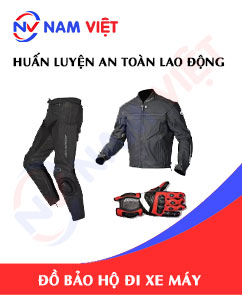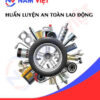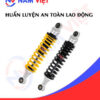Occupational Safety Training for Motorcycle Protective Gear Manufacturing
99,000 ₫
Note: The above price is calculated for one person, and the price may fluctuate depending on the number of trainees participating in the course and market movements. For more accurate pricing support, please refer to the pricing table or contact our consulting staff directly.
Occupational safety is an important issue in factories manufacturing motorcycle protective gear and needs to be addressed promptly to ensure the health and safety of workers, while enhancing the reputation of businesses. The Occupational Safety Training course is one of the effective solutions to raise awareness on how to prevent workplace accidents for workers participating in motorcycle protective gear manufacturing.
Table of Contents
Toggle1. Overview of Motorcycle Protective Gear
a. What is Motorcycle Protective Gear?
Motorcycle protective gear for two-wheelers refers to equipment or clothing designed to protect the safety of riders and passengers while riding a motorcycle. These are mandatory items required by traffic laws, and motorcycle riders must ensure they use them while participating in traffic.
Using motorcycle protective gear helps reduce the risk of injury while riding and is an important part of ensuring safety for both riders and other road users.

b. Machinery for Motorcycle Protective Gear Manufacturing
The types of machinery used in motorcycle protective gear production include:
- Sewing machines: Used to manufacture protective gear such as jackets, protective pants, gloves, and safety socks.
- Heat press machines: Used to press materials such as plastic, rubber, and fabric to create products like helmets and gloves.
- Automatic cutting machines: Used to cut materials such as leather, fabric, and plastic to produce motorcycle protective gear.
- Printing machines: Used to print images and logos on protective products like helmets and jackets.
- Metalworking machines: Used to produce metal components for protective gear, such as helmet locks and reinforcement parts.
These machines are specifically designed to ensure the functionality and quality of protective gear meets safety and durability requirements.

c. Motorcycle Protective Gear Manufacturers in Vietnam
Currently, there are many brands producing motorcycle protective gear. Some well-known and trusted brands include:
- HJC: Based in South Korea, HJC is one of the largest and most reputable helmet manufacturers, supplying helmets to major automobile and motorcycle manufacturers worldwide.
- Alpinestars: Based in Italy, known for protective boots, jackets, pants, gloves, and helmets, designed to meet the highest safety standards.
- Dainese: Based in Italy, known for premium protective gear such as boots, jackets, pants, gloves, and helmets, used by many professional motorcycle racers.
- AGV: Based in Italy, a renowned helmet brand supplying helmets for professional riders and racing teams.
- Shoei: Based in Japan, a famous helmet manufacturer, designing products to meet the highest safety standards and used by professional motorcycle racers.
These brands tend to be expensive, so there are also many other protective gear products available in the market to suit different budgets and user needs.

d. Specific Jobs in Motorcycle Protective Gear Manufacturing Plants
Group 1
- Executive Director, Deputy Director, Department Heads in the protective gear manufacturing plant.
Group 2
- Safety officers: Manage safety in the plant, design safety procedures, supervise and enforce compliance with safe working procedures.
Group 3
- Mold fabrication: Staff create product molds using mechanical or CNC machining, which are used for large-scale production.
- Material production: Some companies produce protective materials such as plastics, fiberglass, and fabrics, requiring specialized processing machines like plastic presses, fabric rollers, and fiberglass presses.
- Product manufacturing: The main task involves producing helmets, armor, gloves, and protective boots using heat press machines, cutting machines, sewing machines, and welding equipment.
- Quality control: Staff inspect each product to ensure it meets safety and quality standards. Defective products are discarded or repaired to comply with standards.
Group 4
- Office, service, sales, and marketing tasks.
- Production management, quality management, human resources, materials management, and finance/accounting.
- Product design: Designers create new designs for protective gear, including helmets, armor, gloves, and boots, with knowledge of materials, production techniques, and safety requirements.

e. Common Types of Motorcycle Protective Gear
Common motorcycle protective gear includes:
- Helmet: The most important protective gear, protecting the head and reducing the risk of traumatic brain injury in accidents.
- Protective jackets: Protect riders from cuts, scratches, and injuries in collisions, usually made from water-resistant and impact-resistant materials.
- Protective gloves: Protect hands from cuts and scratches during collisions, typically made of leather or waterproof materials.
- Protective pants: Protect legs similarly to jackets, made from water-resistant materials with varying degrees of flexibility.
- Protective goggles: Protect eyes and face from dust and wind while riding, usually made from impact-resistant and anti-glare materials.
- Protective boots: Protect feet from cuts and scratches in accidents, typically made of leather or waterproof materials.
Additional protective accessories include helmets, protective masks, and gear bags to enhance safety while riding motorcycles.

2. Overview of Occupational Safety Training for Motorcycle Protective Gear Manufacturing
This article focuses on Group 3 because Group 3 is directly involved in production and faces the highest occupational safety risks. For other groups, refer here.
a. What is Group 3 Occupational Safety Training?
- Group 3 occupational safety training provides workers with awareness of accident prevention methods.
- The training helps workers recognize hazards and avoid risks, reducing workplace accidents during production.
REGISTER FOR OCCUPATIONAL SAFETY TRAINING SERVICE
b. Training Duration
Initial Safety Training
- Total training duration is at least 24 hours, including testing time.
- 8 hours theory on policies and occupational safety laws
- 8 hours theory on basic occupational safety knowledge
- 4 hours theory on specialized training content
- 2 hours practical training on specialized content
- 2 hours final theory test
The safety training center schedules sessions depending on worker availability. Typically, 6 sessions are conducted over 3 days if the company can allocate continuous training time.
Periodic Safety Training
- Before the occupational safety card expires, workers must undergo periodic safety training with a duration at least 50% of the initial training time to renew their card.
Explanation: Total periodic training is at least 12 hours, including testing. Upon completion and passing the test, workers will have their occupational safety card renewed.
c. Training Content
| No. | TRAINING CONTENT | TRAINING TIME (HOURS) | |||
| Total | Including | ||||
| Theory | Practical | Test | |||
| I | Policies and laws on occupational safety and hygiene | 8 | 8 | 0 | 0 |
| 1 | Overview of legal documents on occupational safety and hygiene. | 6 | 6 | ||
| 2 | Standards and technical regulations for occupational safety and hygiene. | 1 | 1 | ||
| 3 | Specific regulations of state authorities on safety and hygiene in construction, expansion, or renovation of production facilities and handling materials or equipment with strict safety requirements. | 1 | 1 | ||
| II | Basic knowledge of occupational safety and hygiene | 8 | 8 | 0 | 0 |
| 1 | Basic knowledge of workplace hazards and risks. | 4 | 4 | ||
| 2 | Methods to improve working conditions. | 1 | 1 | ||
| 3 | Safety culture in production and business. | 1 | 1 | ||
| 4 | Rights and responsibilities of employers and workers; safety and hygiene policies; duties of safety staff. | 1 | 1 | ||
| 5 | Safety rules, signs, safety equipment usage, first aid skills, and occupational disease prevention. | 1 | 1 | ||
| III | Specialized training content | 6 | 4 | 2 | 0 |
| Comprehensive knowledge of machinery, equipment, and hazardous substances; risk analysis, safety management, and safe work procedures. | 6 | 4 | 2 | ||
| IV | Final safety training assessment | 2 | 2 | 0 | 0 |
| Total | 24 | 22 | 2 | ||
See more training content of 6 groups
d. Occupational Safety Card
After completing the safety training and passing the test, workers will be issued a Group 3 Occupational Safety Card (commonly referred to as Group 3 Safety Certificate).
The Group 3 card displays personal information such as name, date of birth, job, and specific work environment. It also shows training duration, red stamp, and signature confirming course completion.
According to regulations in Clause 2 of Article 24, Decree 44/2016/ND-CP, there are two cases:
- If the employer and employee have a labor contract, the employer must sign and stamp the safety card for Group 3 workers after training and passing the test.
- If the worker is freelance or seasonal without a labor contract, the training unit must sign and stamp the safety card after the worker completes training and passes the test.

3. Identifying Hazards Affecting Workers in Motorcycle Protective Gear Manufacturing
Hazards affecting workers in motorcycle protective gear manufacturing may include:
- Fire and explosion risks: Workers in factories producing motorcycle protective gear may be exposed to flammable and explosive substances such as chemicals and oils. Therefore, proper storage, use, and transportation of these substances must be ensured, along with effective fire prevention and firefighting measures.
- Chemical poisoning: Chemicals used during motorcycle protective gear production can cause health issues if not handled correctly. Workers may suffer burns, hearing loss, lung, liver, or kidney damage if protective equipment is not used properly or occupational safety regulations are not followed.
- Occupational accidents: Complex machinery and equipment in motorcycle protective gear production can cause accidents if not operated properly or maintained regularly. Workers may be injured or even fatally harmed if safety regulations are ignored.
- Environmental impacts: Factories producing motorcycle protective gear often consume significant energy and resources, generating pollution and noise during production. Workers may be affected by this environment and face health issues if not adequately protected.
- Electrical hazards: Improperly maintained electrical equipment, insufficient insulation, or lack of waterproofing in the factory can pose electrical shock risks to workers during production.

4. Common Occupational Accidents in Motorcycle Protective Gear Manufacturing
Common occupational accidents during motorcycle protective gear production include:
- Injuries from collisions with hard objects: Workers may be struck or collide with machinery, tools, or other objects, causing minor or severe injuries.
- Chemical hazards: Various chemicals used in production, such as paint, glue, and cleaning agents, can endanger worker health if not used properly or without full protective gear.
- Electric shock: Workers handling electrical equipment without following safety regulations may face electric hazards.
- Transport-related accidents: Workers involved in moving products may interact with vehicles such as trucks, containers, or road traffic. Without safety measures, accidents threatening workers’ lives may occur.
- Machine operation hazards: Using machinery improperly or ignoring safety procedures during production can also cause accidents.
5. Safety Measures When Participating in Motorcycle Protective Gear Manufacturing
To ensure worker safety in motorcycle protective gear manufacturing, the following measures can be applied:
- Occupational Safety Training: Workers need to be trained on production procedures, safety regulations, proper use of machinery and protective equipment, and first aid skills if necessary.
- Use of protective equipment: Workers must be provided with full personal protective equipment such as safety glasses, gloves, masks, waterproof jackets, anti-puncture shoes, etc. Protective clothing should be changed regularly and cleaned to ensure safety.
- Equipment inspection and maintenance: Machinery and equipment must be inspected regularly to detect malfunctions early. Damaged parts should be replaced promptly to ensure worker safety.
- Safe operation techniques: Workers must be trained to operate machinery safely, such as keeping a safe distance, avoiding hands in dangerous areas, and not operating machinery when fatigued or untrained.
- Management and supervision: Production procedures must be strictly managed and supervised to ensure compliance with safety regulations and early detection of safety issues.
- Periodic safety checks: Machinery, equipment, protective gear, and production processes should be regularly checked to ensure safety and prevent potential hazards.
- Regularly conduct occupational environment monitoring in factories, collecting and analyzing harmful factors to workers, and adjusting to reduce risks to prevent occupational diseases.
6. Benefits of Occupational Safety Training for Motorcycle Protective Gear Manufacturing
An Toan Nam Viet provides businesses with the following benefits after completing occupational safety training courses according to Decree 44/2016/ND – CP on occupational health and safety:
- Workers can identify potential occupational hazards and take preventive measures to avoid accidents.
- Businesses can establish risk prevention measures in production, operation, and maintenance processes.
- Reduce costs associated with workplace safety incidents.
- Continuous production helps increase labor productivity and product quality.
- Ensure compliance with occupational safety laws and avoid legal risks.
- Create credibility and professionalism, enhancing the brand of the business.
Nam Viet’s training courses are solutions to prevent external hazards from affecting individuals, helping them avoid injuries or even fatalities.
REGISTER FOR OCCUPATIONAL SAFETY TRAINING SERVICE
7. Customer Feedback After Completing Occupational Safety Training for Motorcycle Protective Gear Manufacturing
An Toan Nam Viet has many years of experience in accompanying numerous businesses in Vietnam in general, and in the southern provinces in particular. This responsibility is extremely valuable to Nam Viet, which is why Nam Viet’s Occupational Safety Training is increasingly professional. The motivation for An Toan Nam Viet’s growth comes from both positive feedback and suggestions from businesses. Below are testimonials from our partners whom we have served.
Bac Nam E&C Construction Investment Joint Stock Company
“My first experience using An Toan Nam Viet’s service was very surprising due to the enthusiastic 24/7 support from the consulting team. Organizing the class was quick and convenient for our company. Thank you very much for Nam Viet’s service!”
Hoa Dat Construction and Trading Joint Stock Company
“Nam Viet’s service has greatly helped us simplify occupational safety and complete safety documentation for the work process. The consulting team responds promptly and enthusiastically to our inquiries. 5 stars for Nam Viet.”
See more customer interviews after using An Toan Nam Viet’s services
8. An Toan Nam Viet’s Occupational Safety Training Capability
An Toan Nam Viet is a reputable and high-quality occupational safety training center in Vietnam. Training sessions are conducted continuously at factories, production workshops, and construction sites nationwide (all 63 provinces of Vietnam).
REGISTER FOR OCCUPATIONAL SAFETY TRAINING SERVICE
Occupational Safety Training License
- An Toan Nam Viet has been inspected and certified by the Department of Occupational Safety under the Ministry of Labor, Invalids and Social Affairs and granted a certificate of eligibility to operate occupational safety and hygiene training. This further strengthens our occupational safety training capability.

Materials and Lectures
- Before occupational safety training materials are used in safety training courses, they are reviewed to ensure accuracy and practical effectiveness.
- Our instructors’ teaching methods follow the standards of An Toan Nam Viet, developed and refined by experts in occupational safety and hygiene training to maximize knowledge absorption for trainees.
Facilities
- Controlling classroom factors that affect training increases teaching efficiency and trainee comprehension.
- Our training facilities include spacious classrooms that meet standards for area, lighting, and training equipment.
9. Nationally Reputable and High-Quality Safety Training Center
At An Toan Nam Viet, we prioritize professional dedication to occupational safety training. Teaching workers how to protect themselves contributes to nation-building.
To ensure effective training, we meticulously prepare everything, from tools, teaching equipment, curriculum, materials, to audio and lighting.
Our occupational safety instructors are experts with many years of experience and research on hazard identification across industries and prevention methods.
Lectures are based on practical experience and delivered in an engaging, easy-to-understand manner. This allows workers to learn comfortably and effectively while complying with Decree 44/2016/NĐ-CP.
Trainees gain knowledge of hazard prevention measures and self-protection techniques, which can be applied appropriately in real work situations.
Our training center is proud to provide reputable, professional occupational safety training services with advantages such as:
- Competitive training costs while ensuring quality.
- Flexible training schedules to match business production.
- Fast, legally compliant issuance of training certificates.
- Experienced instructors with many years in the field.
- Classroom conditions optimized to enhance teaching efficiency and knowledge absorption.
- Lectures tailored to occupational safety in businesses.
- An Toan Nam Viet works diligently and professionally to support clients quickly and accurately.

10. Additional References for Occupational Safety Training in Motorcycle Protective Gear Manufacturing
- Occupational Safety Materials for Motorcycle Protective Gear Manufacturing
- Occupational Safety Training Materials Set
- Occupational Safety Training Tests
- Occupational Safety Training Curriculum for Motorcycle Protective Gear Manufacturing
- Occupational Safety Multiple-Choice Test for Motorcycle Protective Gear Manufacturing
1 review for Occupational Safety Training for Motorcycle Protective Gear Manufacturing
No comments yet















namchinh.haiphong341
Dịch vụ lắm nhé! tôi rất hài lòng với cách làm việc của trung tâm